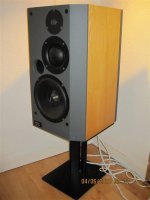Hi all, just wondering if i should change capacitors on my 25year old plus vintage speakers i have aquired? I will post images so people can get an idea of what im dealing with - Just to clarify speakers sound great but maybe a little rolled off on the tweeter but not sure as that might be how the speaker sounded originally. Thanks
Attachments
The yellow and black caps are perfect for the job, wound film foil types with 5% tolerance. The aluminium can type is electrolytic bipolar but if the box sounds good then leave it. If you insist on replacing that cap then a bunch of parallel connected film/foil that add to the same value is the way to go - very expensive tho.
That’s good to know 🙂 and thanks for the speedy reply - think I’ll just leave them as very happy with the sound of the Speaker. Thanks again
In support of your decision, I wouldn't regard 25 years old as vintage, 50 years old would be more of a worry.
If yours was a speaker from the 1970s, I would recommend replacing the electrolytic capacitor, but not if it hails from the late 1990s.
P.S. That electrolytic won't be on the tweeter, so will not affect its sound.
If yours was a speaker from the 1970s, I would recommend replacing the electrolytic capacitor, but not if it hails from the late 1990s.
P.S. That electrolytic won't be on the tweeter, so will not affect its sound.
Replace all of the can electrolytics, every one of them.
Disconnect one side of all of the other components (except coils) and measure the value. If off by more than the tolerance, change them as well.
If you are going to do the job, do the whole job.
Components change over time but also can change due to being abused.
You don't know who those speakers slept with 🙂
P🙂
Disconnect one side of all of the other components (except coils) and measure the value. If off by more than the tolerance, change them as well.
If you are going to do the job, do the whole job.
Components change over time but also can change due to being abused.
You don't know who those speakers slept with 🙂
P🙂
Okay so is this the easiest way to test values? and would you suggest replacing like for like or go down film/foil root as Johno mentioned? and if i do change them will it really make that much of a difference? thats if they are out of value. Cheers for the input
I would just replace bipolar electrolytic capacitors with new bipolar electrolytics of the same values. Sticking to bipolar electrolytics in the positions in which they are installed will ensure you do not upset the crossover characteristics.
The plastic film capacitors do not deteriorate with time so don't require replacing unless damaged - and in your photos there is no sign of them being physically damaged due to overheating. Neither is there any visible overheating damage to the resistors, so I would leave them alone.
I presume you can tell the difference between the electrolytic and film capacitor types?
If not, after removing the crossover boards, take clearer images of the components and attach them to a post - please don't use the pdf method.
Here's how to attach images to your posts: How to attach images to your posts.
Also, please tell us the make and model of your speaker.
The plastic film capacitors do not deteriorate with time so don't require replacing unless damaged - and in your photos there is no sign of them being physically damaged due to overheating. Neither is there any visible overheating damage to the resistors, so I would leave them alone.
I presume you can tell the difference between the electrolytic and film capacitor types?
If not, after removing the crossover boards, take clearer images of the components and attach them to a post - please don't use the pdf method.
Here's how to attach images to your posts: How to attach images to your posts.
Also, please tell us the make and model of your speaker.
Last edited:
Electrolytics that are far out of value can make the speaker sound sickly - lacking in bass for example....if i do change them will it really make that much of a difference? thats if they are out of value.
If I refer back to your comment that the tweeter may be a little rolled off - this is unlikely to be due to an ageing electrolytic - the tweeter will be associated with a plastic film capacitor.
However, if the tweeter contains ferrofluid, then this can go thick with age and dull the tweeter. Ferrofluid Tweeter Repair Kit - Willys-Hifi Ltd
That's why supplying the make and model of your speaker would be helpful.
Ferrofluid is not mentioned in the user manual: https://www.dali-speakers.com/media/3397/dali-15a.pdf
Hi Galu, thanks for all the info - the bass on the speakers are working fine so maybe im good to leave the electrolytic caps and seeing as film caps are in good shape then i think the speakers seem good 🙂 thanks again for helping out and might consider changing electrolytics down the line. Cheers
- Home
- Loudspeakers
- Multi-Way
- Change capacitors 25 year old + vintage speaker
